Abstract
The present study evaluates the effect of a substrate’s silicon content on the coatings’ morphology, structure, and properties in an electrolyte containing sodium tungstate on Al–xSi alloys. The PEO-coated samples demonstrated the structure of the pancake and crater with irregular micro-cracks and micro-pores. The incorporation of the element W in the coatings decreased the surface roughness and porosity due to increasing the electrolyte conductivity and, hence, decreasing the breakdown voltage and intensity of micro-discharges. The friction coefficient of all the coatings stayed constant during the wear test due to the contact of the ball with the inner layer with less porosity and higher micro-hardness. The track depth to the thickness ratio of the coatings was found to be 0.60–0.75 for those without additive coatings and 0.55–0.65 for those with additive coatings. As a result, the higher wear rates, volume losses, track widths, and depths in the specimens with a lower silicon content of the substrate were found due to the greater thickness of the coating and the outer sublayer for both specimens with and without Na2WO4. The coatings formed using the W-containing electrolyte showed a higher micro-hardness and a lower wear rate in comparison with the coatings produced in the silicate-based electrolyte.
1. Introduction
Today, the transportation industry is looking for fuel-efficient vehicles with low pollution emissions. Therefore, the weight loss parameter has become an effective parameter in automotive design. According to certain studies, for every 10 percent reduction in vehicle weight, fuel consumption is reduced by 6 to 8 percent [1]. Recently, aluminum alloys, as one of the light alloys, have been increasingly considered both technically and economically [2]. Due to their good mechanical properties, suitable thermal conductivity, low coefficient of thermal expansion, great castability, and, in particular, high strength-to-weight ratio, cast Al–Si alloys are a promising material used in automobiles, such as engine blocks [3,4,5]. Nevertheless, weak corrosion and wear resistance often reduce the lifetime and performance of cast Al–Si alloy parts. Combustion cylinders of reciprocating engines made of aluminum often use steel liners to protect against thermal stress and wear. Currently, thermally sprayed and Ni–SiC coatings on vehicle engines are being frequently utilized [3]. However, significant studies have been dedicated to improving the wear performance of Al–Si parts via modifying their composition and surface structure. Electrochemical processes have been developed for the surface treatment of automotive components. The anodizing treatment is performed on cast Al–Si alloys with an oxide layer of low thickness and quality due to the presence of a high silicon content and other elements (e.g., Fe and Cu) that may lead to the nonhomogeneity of the components and corrosion attacks in these regions [6,7]. Mora-Sanchez et al. [8] investigated the hard-anodizing and Plasma Electrolytic Oxidation (PEO) processes on an Additively Manufactured (AM) Al10Si1Mg alloy and a conventional A361 cast alloy. Their findings revealed that PEO coatings demonstrate superior wear protection compared to HA due to the formed phase composition in both alloys.
PEO treatment is a plasma-assisted electrochemical surface process that produces an oxide base ceramic layer on the light alloys that have a higher life in the long term than the Ni–SiC coating [9]. This coating has demonstrated high corrosion, wear resistance, and thermal stability. The PEO coating process is a complex physical, chemical, and electrochemical process that consists of simultaneous partial processes, including oxide film formation, dissolution, dielectric breakdown, gas ionization, plasma formation, and the incorporation of electrolyte constituents under plasma conditions. The PEO process takes place in an environmentally friendly alkaline electrolytic solution with a voltage higher than the dielectric breakdown potential of the oxide layer, in the order of several hundreds of volts, which causes micro-discharges to occur. Dielectric breakdown occurs when the current density exceeds the tolerance limit of an electrical insulator due to an increase in voltage. In this condition, the electrical insulator behaves similarly to an electrical conductor. Dielectric breakdown is usually a momentary phenomenon associated with an electrostatic micro-discharge or sparking phenomenon on the metal surface. PEO coatings usually consist of two distinct layers, a porous layer and a more compact layer, which originate from strong micro-discharges, gas evolution, and entrapping [10,11]. Due to the multiple parameters of the PEO process, there are many strategies to restrict and diminish the thickness of the outer layer, such as electrical parameters and electrolyte composition. The wear resistance is influenced by the composition and the microstructure of the coatings that originate from the composition of the base alloy and species in the electrolyte [12]. Wang et al. [13] revealed that the higher silicon substrate (cast hypereutectic 390 alloys~17% Si) led to a more violent coating surface. They have not evaluated the effect of the composition of the substrate on the wear resistance. PEO coatings formed on Al-Si alloys are commonly composed of Al2O3, SiO2, and mullite [5,13]. However, the use of additives in the electrolyte can provide high wear resistance and surface micro-hardness on Al-Si alloys via alteration in the composition, structure, and porosity percent [14,15]. Tungsten is a refractory metal with a unique set of properties such as a high melting point, a high elastic modulus, and excellent mechanical properties at elevated temperatures. Thus, the use of W-containing electrolytes has increased due to the catalytic, semiconductive, inhibitory, corrosive, and wear-resistant properties of the resulting coatings [16,17,18]. Hence, their incorporation may be helpful to the performance of PEO coatings. According to ref. [19], sodium tungstate (Na2WO4) enhances the micro-hardness of the surface. Additionally, tungsten-containing coatings produced on 7075 Al alloys revealed enhanced wear, corrosion, and tribocorrosion resistance [20,21]. Yan et al. [18] investigated the effects of different concentrations of Na2WO4 on the mechanical properties and wear resistance of the micro-arc oxidation (MAO) coatings formed on a 2A12 aluminum alloy. The results have shown that the thickness and the surface roughness of the coating increased with the increase in the Na2WO4 concentration. However, the wear rate decreased first and then increased. Limited studies are available for PEO coatings on Al–Si alloys. Furthermore, the effects of the silicon content, the different phases in the substrate, and the presence of sodium tungstate as an additive in the electrolyte on the microstructure, phase composition, micro-hardness, and wear resistance have not been systematically studied.
The present work studies the role of silicon and the formation of different phases on plasma-electrolytic oxidation coatings on Al–Si binary alloys modified with an Al-10 wt.% Sr alloy. Accordingly, the amount of Si has been changed systematically; therefore, special interest was paid to evaluating the surface morphology, structure, composition, and wear resistance of the produced coatings in silicate-based electrolytes with and without Na2WO4 as an additive.
2. Materials and Methods
2.1. Specimen Preparation
Al–x Si alloys (where x = 1, 3, 5, 7, 9, 11, and 13% wt.%) with the chemical composition described in Table 1 were employed as the substrates. These alloys were formed by a casting process. For the preparation of binary aluminum–silicon alloys with different Si content, commercial aluminum and silicon were melted at a constant temperature of 750 °C in an electrical resistance furnace to create the Al–xSi alloys by conventional gravity casting. In addition, alloys were improved via an Al–10 wt.% Sr alloy modifier during a melting treatment. A mechanical stirrer dispersed the master alloy uniformly in the melt and the Sr amount was protected at about 0.1 wt.%. The chemical composition analysis of metallic substrates was performed by emission spectrometry (ES, W.A.S model FOUNDRY MASTER) as shown in Table 1. The selection of the silicon percentage of the substrate is based on the phase diagram with different stable phases; in addition to the effect of increasing the silicon percentage, the effect of the phase structure is also investigated. The stable phases related to each sample are shown in Table 1. The two flat faces of disc-shaped specimens (Ø × H = 20 mm × 5 mm) were polished using SiC abrasive papers (up to 1200). They were cleaned with deionized water, ultrasonically degreased in acetone for 3 min, and then connected to an aluminum wire that was prepared for oxidation as a working electrode.

Table 1.
The chemical composition of the alloys was determined with emission spectrometry.
2.2. Plasma Electrolytic Oxidation (PEO) Process
PEO process was carried out in a 70 L electrolyte of silicate-based electrolyte containing 10 g L−1 sodium metasilicate pentahydrate (Na2SiO3.5H2O), 2 g L−1 potassium hydroxide (KOH), and 3 g L−1 sodium tungstate dihydrate (Na2WO4.2H2O), which was used as an additive for producing W-containing coatings. A centrifugal pump was used to strongly stir the electrolyte and retain its temperature at 25 ± 2 °C. The electrolyte pH value of 12.46 ± 0.1 and conductivity of 18.5 and 21.8 mS cm−1 were measured for the electrolyte without and with additives, respectively. The 316L stainless steel sheets were employed as counter electrodes, placed on both sides of the PEO cell. The PEO process was conducted by a power source (700 V/30 A) equipped with an Isolated Gate Bipolar Transistor (IGBT)-based pulse converter with the capability of delivering a symmetric bipolar current mode utilized for employing the pulsed waveform. The samples were coated for 30 min with 20% positive and 20% negative duty cycles at 1 kHz, while anodic and cathodic current densities were 10 and 8 A dm−2, respectively. The codes of the coatings formed on various substrates with different amounts of silicon content (1, 3, 5, 7, 9, 11, and 13 wt.%) in the base electrolyte were defined from S1 to S13 and in the electrolyte containing sodium tungstate from S1W to S13W.
2.3. Coating Characterization
The surface, microstructure, and cross-sectional morphology of coatings were studied by scanning electron microscopy (SEM, model FEI ESEM QUANTA 200, Materials Research Facility, Texas, USA). The cross-section of the coatings was ground down to 2400 grit of SiC and then polished by alumina particles (0.5 microns). Metallurgical image-processing (MIP) software and ImageJ 1.44p software were used to assess the porosity percent and average thickness of the cross-sections of SEM images, respectively. A stylus profilometer (model Mitutoyo SJ 210, Mitutoyo, Kawasaki, Japan) was utilized to calculate the average surface roughness of coatings. The constituent phase of the coatings was determined using a grazing incident beam XRD (GIXRD, model ASENWARE AW-XDM300, Asenware, Shenzhen, China). The X-ray diffraction patterns were taken at the measurement range of 20 to 80° using a Cu Kα (40 kV, 30 mA, and λ = 0.15406 nm). The step size, step time, and incident beam angle were 0.05°, 3 s, and 10°, respectively. The XRD patterns were analyzed using the PDF2 database.
2.4. Micro-Hardness and Wear Measurement
The Vickers micro-hardness tests (model FM-700, Futcher Tech, Kawasaki, Japan) were performed with a load of 5 N and 10 N and a time of 15 s on the substrate and coatings, respectively. Each micro-hardness value was the average of 3 measurements. The wear treatment of the coatings was studied using a tribometer machine in a rotational pin-on-disc system with the ASTM G99 standard while specimens served as the disk with a diameter of 50 mm. The tests were carried out with 5 N as a normal load applied by a WC ball (Ø = 10 mm) as the counter body was placed at a 10.6 mm radius at a sliding velocity of 0.15 m s−1. The experiments were terminated when the overall sliding distance achieved 1000 m; then, the wear tracks of the specimens were evaluated by SEM, and their volume reduction was determined by a stylus profilometer. The geometries of the wear tracks were also determined. The coefficient of friction (COF) was measured during wear testing using a dynamometer linked to a computer.
3. Results and Discussion
3.1. Microstructure and Micro-Hardness of the Substrates
Figure 1 displays the microstructure of an Al alloy with different Si content as well as their phase percentage using a metallography treatment, which was obtained by optical microscopy and by MIP software, respectively. Based on the Al–Si phase diagram [22], the prepared alloys were selected in different areas of phase stability. As seen in Figure 1, the dark particles are silicon, while the lighter-colored matrix is a solid electrolyte of aluminum and silicon. The 1 wt.% Si was formed from the Al matrix and fine patches of Al–Si eutectic, generally at the grain boundary triple (Figure 1). From 3 to 11 wt.%, Si alloys were selected in the hypoeutectic area composed of the α-Al dendrites and the Si particles in the eutectic with an interdendritic distribution, as seen in Figure 1. With an increasing silicon percentage, the amount and size of the α-Al dendrites were reduced, and the eutectic phase was increased. The 13 wt.% Si alloy is in the hypereutectic area that is composed of primary bulk proeutectic β-Si and the eutectic (α + β) phase. The tiniest eutectic Si was surrounded by the relatively larger eutectic Al. The addition of the Sr element led to a very well-modified microstructure, changing continuous flakes to disconnected smaller fibers [6,7]. Accordingly, the fine eutectic silicon particles were uniformly incorporated into the matrix.
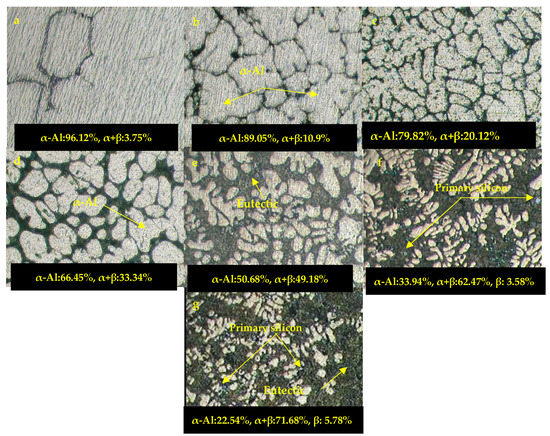
Figure 1.
Optical images of different Al–Si alloys: (a) Al-1 wt.% Si (S1), (b) Al-3 wt.% Si (S3), (c) Al 5 wt.% Si (S5), (d) Al-7 wt.% Si (S7), (e) Al-9 wt.% Si (S9), (f) Al-11 wt.% Si (S11), and (g) Al-13 wt.% Si (S13). The images show the phase percent view obtained from MIP software.
As shown in Figure 2, the Vickers micro-hardness (HV, load = 5 N) of the substrates with different Si content was measured. It can be seen that the micro-hardness of S1 and S3 is nearly equal but increases linearly with an increasing Si content from 5 to 13 wt.%. For this reason, higher micro-hardness values were observed in alloy S13. The presence and increased Si content increased the micro-hardness and, reciprocally, the wear resistance. However, the coarse and continuous eutectic silicon phase is inherently brittle. Therefore, the fine silicon particles generated by the Sr modifier retard micro-crack nucleation and growth processes [23,24].
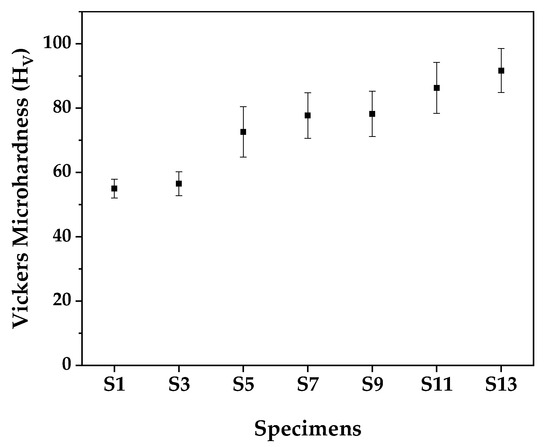
Figure 2.
The effect of Si content on the micro-hardness of the Al–Si alloys.
3.2. Voltage Variation during PEO Treatment
Figure 3a,b show the relationship between the output positive and negative voltage change and PEO treatment time on Al alloys with different Si content with and without a Na2WO4 additive in the electrolytes. The voltage curves follow a similar pattern as reported in previous review studies. Based on Figure 3, four successive micro-discharge stages can be recognized in the cathodic and anodic voltage diagrams versus time. In stage I, with the increase in the current density over time, the anode and cathode voltage increase linearly at a high rate, and dielectric breakdown takes place. At this stage, only the process of anodic oxidation and the rapid electrochemical formation of an oxide film as a primary insulator on the surface of aluminum occurs, which is due to the fact that the silicon element has a low electrical conductivity, and at this stage, it is created only by the chemical absorption of a passive layer on it [13]. As the percentage of silicon in the substrate increases, the amount of aluminum decreases; therefore, less aluminum can be oxidized at this stage. As a result, the growth rate of the oxide layer is higher in the specimens with a low percentage of silicon, so the electric potential increases to a greater extent [13]. On the other hand, the dielectric constant of alumina (11.1–7.8) is greater than that of silica (3.6–4.2). Accordingly, alumina has a greater resistance to electric current. As a result, by increasing the percentage of silicon in the substrate and increasing the silica and other silicon-containing compounds in the coatings, the dielectric breakdown voltage decreases. This trend occurs in both situations with and without an additive, but the S13W specimen has the highest breakdown voltage compared to the same specimen and the S1W specimen. Furthermore, the breakdown voltage of the tungstate-containing specimens is lower than that of the specimens without additives. Researchers attribute the drop in voltage in the presence and during the increase of tungstate concentration to the surface adsorption of WO42− anions and their role as a micro-discharge center. Increasing the number of micro-discharge centers causes the voltage to decrease [25]. On the other hand, adding Na2WO4 to the electrolyte increases the conductivity of the solution. Increasing the electrolyte conductivity reduces initial and final voltage values [26]. In this stage, the rate of cathode voltage growth is also affected by the silicon percentage of the substrate, which raises the slope of the graphs. In addition to the formation of the oxide layer, hydrogen release processes in the holes as well as the absorption and participation of anions and cations also occur in this stage [27,28].
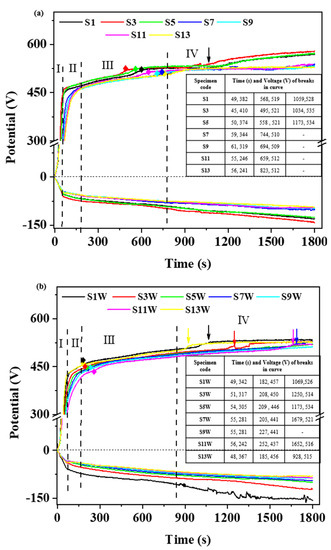
Figure 3.
Voltage–time response curve recorded during the PEO process in the various coating solutions (a) without and (b) with Na2WO4 additive. The attached table presents the time and voltage of breaks in the curve of different PEO stages.
In stage II, the voltage is slowly increased, and white, glowing micro-discharges uniformly scan the surface of the specimen, which is in agreement with other references [5,29,30]. The heat generated by the micro-discharge of micro-arcs causes the temperature to exceed the melting point of silicon and silicon oxide, allowing the molten silicon to be combined with aluminum to produce aluminum–silicon-oxide compounds that have a lower melting point than aluminum oxide [13]. The emission of hydrogen gas facilitates electron transfer through the oxide layer, and the pH near the surface of the specimens increases due to local alkalization, which promotes the formation of aluminum hydroxide complexes. On the other hand, the acidification of the pH in the vicinity of silicon in the grain compared to the primary silicon in the hypereutectic alloys prevents the dissolution of silicon [31]. In addition, trapped hydrogens in the micro-discharge channels raise the plasma temperature and facilitate the conversion of complex aluminum hydroxide compounds into oxides and hydroxides in the channels [32,33]. The occurrence of the aforementioned phenomena in the micro-discharge channels provides the conditions for the repair and sealing of micro-pores and effectively provides sparking conditions in other areas of the coating during the PEO process with bipolar waveforms.
In stage III, the anode voltage slowly increases as the process continues and the coating gradually grows and causes the formation of yellow micro-discharges. This stage is called the micro-arc oxidation stage [34]. In the diagrams, a break is observed during the transition from stage III to stage IV. This failure can be attributed to the critical voltage, after which the diagram enters the arc oxidation stage [35]. As the percentage of silicon increases, the critical voltage decreases. The formation of silicon compounds and the increase in their incorporation as crystalline and amorphous phases in the coating reduces the dielectric constant of the coating, resulting in a decrease in the coating resistance. As a result, the critical breakdown voltage is decreased.
In stage IV, the composition of the coating is more determined by the electrolyte than the substrate; for this reason, the voltages become almost the same [36]. However, in the anode voltage diagram of specimens S3, S1, and S5, and in all the diagrams of the specimens containing additives except the S9W specimen, a sudden increase occurs (shown with an arrow in Figure 3), indicating the re-breaking of the oxide coating and the possibility of providing the growth conditions of the coating. Therefore, the presence of a sodium tungstate additive increases the growth rate of the coating in the final stages. Furthermore, raising the silicon percentage of the substrate to more than 5% in the specimens without additives and more than 3% in the specimens with additives raises the ultimate cathode voltage difference of the specimens. An increase in the cathode voltage increases cathode micro-discharges and, as a result, the coating’s spalling phenomenon [37]. As the PEO time increases, the size of the micro-arcs increases and their number decreases. According to Figure 3, the change in the chemical composition of the substrate (the change in the percentage of silicon) can change the voltage–time response graphs of the produced coatings and affect the growth rate of the coatings. The decrease in the breakdown and final voltage can be attributed to the oxidizing property of SiO32−. Since a considerable quantity of silicon oxide and aluminum compounds were introduced into the coating, the conductivity of the coating increases as compared to the coatings containing Al2O3 aluminum oxide, causing the specimen’s voltage to drop during the process. Therefore, the sparks are less intense, which can reduce the coatings’ thickness and roughness.
3.3. The Characterization and Analysis of Coatings
3.3.1. Coatings’ Surface Morphology and Chemical Composition
Figure 4 and Figure 5 demonstrate the coatings’ surface morphology determined by SEM. The morphology of all the coatings contains structures of pancakes and craters, featuring micro-cracks, micro-pores, and nodular particles. Each of the formed microstructures has an origin, such as the accidental micro-discharge channels, gas entrapment, and ejected materials, which are usually caused by the granules of oxide combination and micro-pores [38]. In addition, the pancake and crater features are created by the fast quenching of the molten alumina after being ejected from micro-discharge channels [21,39]. Micro-cracks are evident on the coatings’ surface due to the thermomechanical stresses built up by the fast-quenched molten oxide with circumambient electrolytes. The difference in the thermal coefficients between the oxide layer and the substrate, as well as the high pressure governed by the PEO process, increase the number of micro-cracks [40,41].
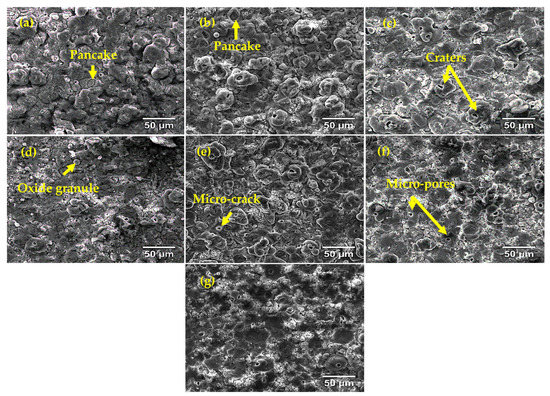
Figure 4.
Surface morphology of the produced coatings: (a) S1, (b) S3, (c) S5, (d) S7, (e) S9, (f) S11, and (g) S13.
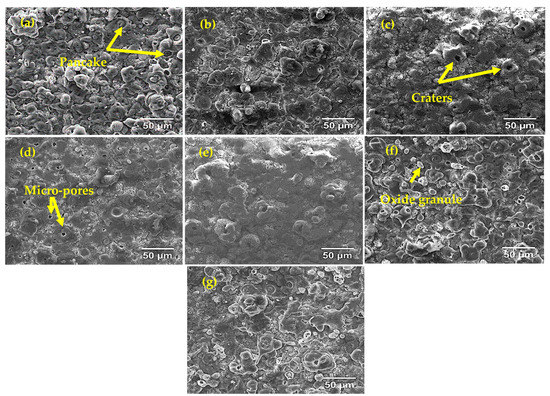
Figure 5.
Surface morphology of the produced coatings: (a) S1W, (b) S3W, (c) S5W, (d) S7W, (e) S9W, (f) S11W, and (g) S13W.
As seen in Figure 4 and Figure 5, by increasing the Si content of the substrate, the surface morphology of the coatings becomes smoother. According to the literature [42,43], many bright areas that are found on the surface of high-Si specimens are mainly composed of silicon oxides (as seen in Figure 4g,f and Figure 5g,f). However, the surface morphology of the coatings produced in the additive-containing electrolyte showed negligible changes compared to those without an additive, as is seen in Figure 5. In addition, it is very difficult to identify the effect of the primary structure of the substrate on the surface morphology for both coatings with and without additives.
Figure 6. shows the EDS analysis of surface morphology. According to the results of the analysis presented in Figure 6, it can be seen that the atomic percentage of silicon elements is higher in the areas with a nodular morphology (i). They were created by A- and C-type micro-discharges occurring in the surficial holes. The participation of tungsten in the nodular morphology is further due to A- and C-type sparks. However, in areas with pancake (ii) and crater-like (iii) morphologies, the atomic percentage of aluminum is higher, and this is a sign of the formation of B-type micro-discharges in these areas and the possibility of accessing the substrate. As seen in Figure 4 and Figure 5, the nodular morphology increases with the increasing silicon content in the substrate, which indicates the greater participation of silicon in the coating due to the substrate and electrolyte. When the molten substrate is ejected out of the substrate–coating interface through the micro-discharge channels, it is oxidized and solidified in contact with the cold electrolyte. Anionic components such as SiO32− enter the channels and create various compounds around the micro-discharge channels. It is believed that the edges of the melting pools and areas further away from the center of the channel contain more silica and aluminosilicate phases than the areas closer to its center [44].
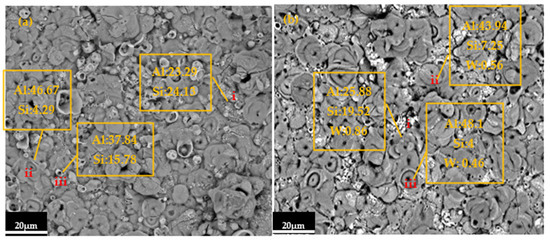
Figure 6.
The EDS analysis of different surface morphologies of the produced coatings: (a) S1 and (b) S1W.
3.3.2. Characterization of Cross-Section
Figure 7 and Figure 8 show SEM cross-sectional images of the coatings and their porosity percentages. The formation of the substrate/coating interface with a wavy-jagged appearance can be due to the dissolution of α-Al dendrites from the substrate in the primary stage of the oxidation treatment [45]. The continually localized thickening of the coating, followed by the nonuniform distribution of micro-discharge events, causes the change in the final coating’s thickness [46]. The cross-sections demonstrate that the coatings are made up of two distinguished layers, especially in the substrates with low silicon content (S1 and S1W): a porous outer layer and a more compact inner layer [47]. Evidence of micro-cracks and micro-pores due to continuous micro-discharges and thermal stresses during the PEO process can be seen on the cross-sections of the coatings. Based on the growth model described by ref. [48], five types of micro-discharges (B, A, C, and E) may occur during micro-arcing in the PEO treatment. The B-type micro-discharge, which forms deep channels connected to the substrate and appears as a pancake morphology on the coating’s surface, occurs at the substrate/coating interface. The A-type micro-discharge, which creates a crater-like surface morphology, occurs on the upper side of the coating at the oxide/electrolyte interface or is adhered to gas bubbles attached to the coating’s surface. The micro-discharge type C, which makes nodular features, happens at the oxide/electrolyte interface within the micro-pores and micro-cracks of the coating. The micro-discharge type D occurs inside the large micro-pores at the inner/outer oxide layer interface. Finally, the E-type, which forms deep channels connected near the inner/outer oxide layer interface and creates a pancake morphology [30]. As seen in Figure 7 and Figure 8, the common discharge types are A, C, D, and E. Micro-discharge type E occurs near the inner/outer oxide layer interface, forms deep channels, and creates pancake features. Here, there are no intensive micro-discharges such as the B-type, which creates deep micro-pores at the oxide/metal interface. Moreover, there is no band showing a micro-pore at the oxide/substrate interface of the coating, which reveals the high bonding strength between the substrate and the coating. The large discrete micro-pores shifted to the middle and upper parts of the coatings due to the occurrence of types A, C, and D. The examination of the cross-sections revealed the advantages of using Na2WO4 to increase the thickness and decrease the porosity of the coatings.
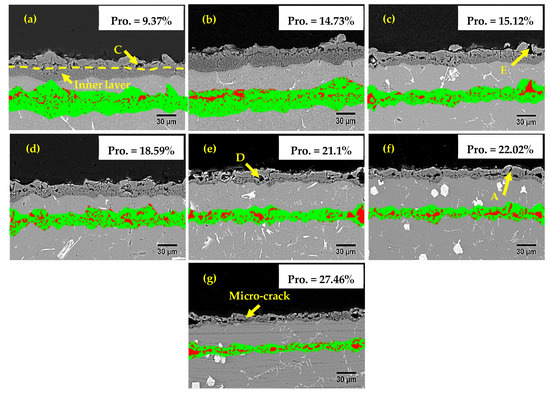
Figure 7.
SEM images of cross-sections of the PEO-coated sample in the silicate-based electrolyte on different Al–Si alloys: (a) S1, (b) S3, (c) S5, (d) S7, (e) S9, (f) S11, and (g) S13. The images appended under each cross-sectional image show the porosity percent view obtained from MIP software.
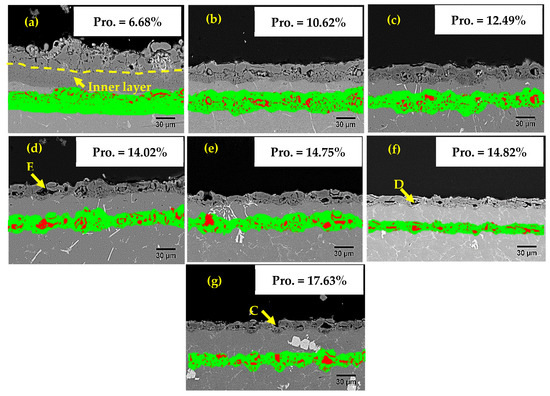
Figure 8.
SEM images of cross-sections of the PEO-coated sample in the silicate-based Na2WO4 additive electrolyte on different Al–Si alloys: (a) S1W, (b) S3W, (c) S5W, (d) S7W, (e) S9W, (f) S11W, and (g) S13W. The images appended under each cross-sectional image show the porosity percent view obtained from MIP software.
Figure 7 and Figure 8 display the porosity percent of the coatings measured from SEM cross-sectional images using the MIP software. The increment of A- and C-type micro-discharges and the elimination of strong micro-discharges reduced the porosity percentages [11,49]. According to the cross-sectional images, which consist of many small micro-pores that are not connected to each other and are present in the middle of the oxide layer, the most common type of micro-discharge in the formed coatings is the type D micro-discharge. Furthermore, the cathodic half-cycles can enable the coating to become less porous [28]. The highest and lowest porosity percentages were measured for the S13 (i.e., 27.46%) and the S1W coating (i.e., 6.68%), respectively. The coatings obtained in the electrolyte comprising Na2WO4 have a lower porosity percent due to the lower and finer sparks obtained in its electrolyte than the corresponding coatings produced in the absence of additives.
The addition of Na2WO4 to the electrolyte increases the conductivity. The increasing electrolyte conductivity decreases the values of the initial and final voltage. The reduced voltage in turn reduced the intensity of the micro-discharges and the percentage of porosity [26]. On the other hand, the porosity percent increments with the increasing silicon content of the substrate. The presence of Si crystals produces local current shielding during oxidation since Si requires higher voltages than Al to be oxidized [8]. Therefore, more intense micro-sparks occur in the areas of silicon’s presence, and the percentage of porosity increases.
Figure 9 and Figure 10 display the element distribution maps in the cross-section of the coatings. Al from the substrate is uniformly dispersed over the thickness of the coatings. The incidence of A and C-type micro-discharges permits the incorporation of electrolyte compounds in the coating [39]. As seen in Figure 9 and Figure 10, Si from the electrolyte is found mainly on the top surface of the outer layer. In addition, Si exists inside the micro-pore walls located beneath the outer layer. This case confirms the increased porosity with the increasing amount of silicon substrate. The intensity of silicon increases when increasing the Si content of the substrate. Although the intensity of W is very low for all the specimens prepared by the electrolyte containing Na2WO4, W is dispersed all over the cross-section of the coatings.
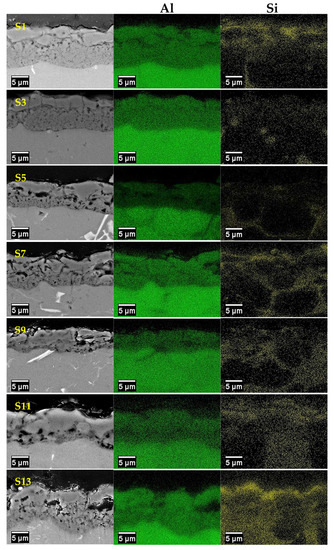
Figure 9.
The elemental map on the cross-section of the PEO specimens prepared by the silicate-based electrolyte consists of Al and Si elements marked by green and yellow colors, respectively.
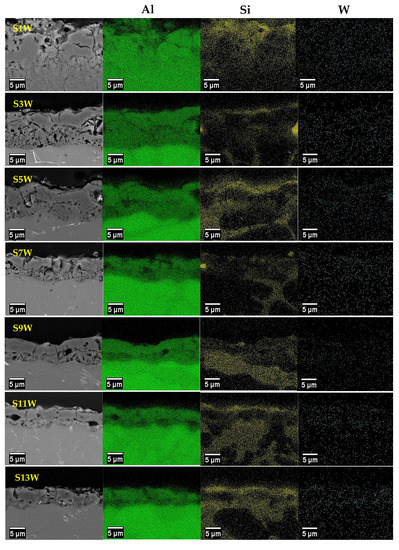
Figure 10.
The elemental map of the cross-section of the PEO specimens prepared by the silicate-based electrolyte containing Na2WO4 that consists of Al, W, and Si elements, denoted by green, blue, and yellow, respectively.
Figure 11 depicts the elemental composition (atomic percentage (at.%)) of Al, Si, O, and W on a cross-section of the coatings. As the percentage of Si (wt.%) increases in the substrate, the Si atomic percentage increases in the coating, but this increase is not linear. It is considered that the Si in the PEO coating on the substrate with low silicon comes from SiO32− in the electrolyte during the PEO process, which is in agreement with the coating on pure aluminum treated by PEO in a silicate-based electrolyte. However, the Si content increases with the presence of the eutectic phase (shown in S7, S9, and S11 specimens), which means that the content of Si in the coatings on the substrate with the eutectic phase is higher than the one on the substrate with the α-Al dendrite phase. This may be related to eutectic Si oxidation, which increases the amount of silicon in the coating, in agreement with ref. [5]. Nevertheless, the Si content of the specimens coated with an electrolyte containing Na2WO4 is lower than the corresponding coatings of the silicate-based electrolyte. Chen et al. [26] demonstrated that the WO42− anions could prevent the incorporation of SiO32− anions into the PEO coatings. As a result, more oxygen is spent on aluminum oxidation in the tungsten-containing coatings. The concentration of W did not change significantly with the different Si content of the substrate.
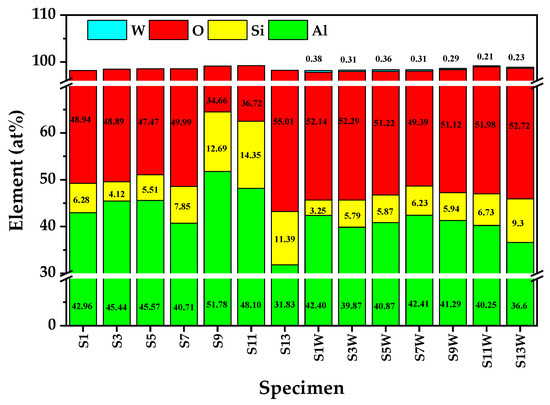
Figure 11.
Elemental composition of cross-sections at the near-surface of coatings obtained using EDS analysis.
3.3.3. The Surface Roughness and Thickness of the Coatings
Figure 12 depicts the average thickness values of the PEO coatings calculated using the ImageJ software from SEM cross-sectional images. As seen in Figure 12, the average thickness decreased with the increasing Si content of the substrate for both specimens with and without additives, which is also in agreement with the literature [6]. The presence of silicon elements in the substrate acts as an obstacle to the coating growth by decreasing the effective area for the formation of conversion products, and thus the coating growth rate is slowly slaked [50]. Since silicon needs greater voltages than aluminum to be oxidized, the coating has a lower thickness in the eutectic regions [8]. According to Figure 12, the average thickness of the coatings obtained in the electrolyte containing Na2WO4 (S1W) is 64.6 ± 3.2 μm, whereas it is 28.8 ± 0.7 μm for the S1 coating, i.e., almost two times higher than S1. The WO42– ions from the electrolyte are transferred inside through the micro-discharge channels in the oxide layer, assisted by the high electric field, and incorporated as black WO3 compounds in the following oxidation reaction [51,52]:
2WO42− → 2WO3 + O2↑ + 4e
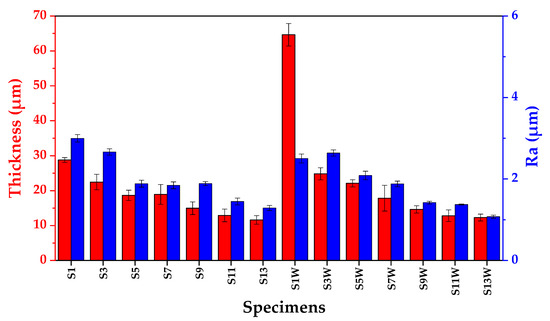
Figure 12.
The average surface roughness and average thickness values of the PEO coatings (The red curve is related to the average thickness, and the blue curve is related to the average surface roughness (Ra)).
The formed WO3 can react with aluminum at the high temperature inside the coating’s micro-discharge channels [25]:
WO3 + 2Al → Al2O3 + W
The oxidation reaction of the aluminum is intensified with the release of oxygen and electrons. On the other hand, the reduction reaction of tungsten oxide (reaction 2) causes the formation of aluminum oxide, which in this case increases the thickness of the coatings in the presence of tungstate ions.
The average surface roughness (Ra) has been reported in Figure 12. As seen in Figure 12, the highest Ra is related to the S1 specimen. The average roughness decreased with the increasing Si content of the substrate for both specimens without and with additives. As the percentage of silicon in the substrate increases, the possibility and amount of silicon oxide formation also increase. The formation of SiO2 in the coating reduces the dielectric constant and results in a decrease in the coating’s resistivity, thus leading to a reduction in strong micro-discharges [53]. Moreover, the surface roughness increased with the increasing thickness of the coatings, since with an increasing thickness, more power is needed for the current to transit across the oxide layer. Under this condition, the current is focused on weak points and finds a way to achieve the formation of the oxide layer. As a result, the size of the micro-discharge channels increases and more molten oxide erupts, resulting in a higher surface roughness [54]. The Ra of additive-containing specimens is lower than that of the corresponding specimens without additives. The addition of Na2WO4 to the electrolyte increased the conductivity. Voltage reduction due to the increased conductivity of the electrolyte reduces the intensity of micro-discharges. Thus, the Ra of the produced specimens with the electrolyte containing WO42– ions was reduced [26].
3.3.4. The Phase Analysis
Figure 13 illustrates the X-ray diffractometry results of the PEO coatings produced in the electrolytes with and without Na2WO4 on the various substrates. The coatings that formed are mainly composed of alumina with different allotropes such as γ-gama, δ-delta, and η-eta (γ-Al2O3-ICDD PDF no. 29-0063, δ-Al2O3-ICDD PDF no. 04-0877 and η-Al2O3-ICDD PDF no. 21-0010). The γ-Al2O3 could be derived directly from molten oxide during the supercooling throughout the PEO process [30]. According to the literature, using Na2WO4 as an additive results in the formation of a more stable crystalline phase of α-Al2O3. However, the transformation of γ-Al2O3 to the α-Al2O3 phase requires tremendous energy prepared by the micro-arc to dominate the energy barrier [26,42]. The transforming drive force increases with the rise in the temperature. In agreement with ref. [16], the lack of an α-Al2O3 peak illustrates that the amount of the employed current density and the reaction times are not enough to support this phase transformation. Furthermore, according to Figure 13, the coatings include mullite (Al6O13Si2-ICDD PDF no. 02-1160) and SiO2 (ICDD PDF no. 80-0374). The silicon, which places mullite and silica in the formed phases list, originates from both the silicate-based electrolyte and the substrate. The aluminosilicate phases can be related to both the oxidation of aluminum by silicate anions into the electrolyte and silicon in the eutectic phase [31]. The coatings formed in an electrolyte containing Na2WO4 show the obvious peaks corresponding to metallic tungsten (W-ICDD PDF no. 89-3728) in addition to the above-mentioned phases, which reconfirm the incorporation of tungsten into the coatings. The diffractions relating to Al (ICDD PDF no. 85-1327) and Si (ICDD PDF no. 47-1186) from the Al–xSi alloy substrate are also evident but diminish as the thickness grows and the porosity of the coatings decreases. The presence of a mound in the 2θ confines of 20–45° in the diffraction patterns can represent amorphous phases such as silica and alumina. Due to a decrease in the thickness and an increase in the crystallization conditions, the number of amorphous phases decreases as the silicon percent of the substrate rises.
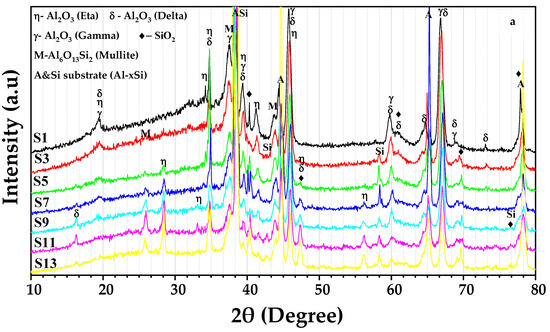
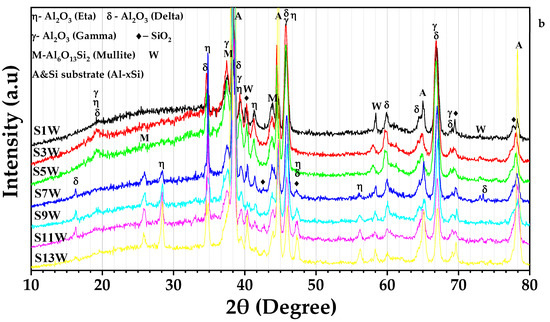
Figure 13.
XRD patterns of the PEO-coated specimens on substrates with various Si content in (a) without and (b) with Na2WO4.
3.4. Wear Behavior
Figure 14 shows the coefficients of friction (COF) versus sliding distances. The surface roughness of the PEO coatings affects the coefficient of friction [55,56]. The Ra value reduces as the Si content of the substrate increases; thus, the contact points increase between the WC ball and the coatings [57]. On the other hand, the thicker coatings illustrated a lower COF in comparison to the thinner ones, in agreement with ref. [58]. As a result, the higher the Si content, the higher the COF of the coatings, and vice versa. Overall, slightly higher COFs were obtained for the tungsten-containing coatings due to lower Ra than the corresponding ones without additives. On the other hand, the presence of tungsten in the coating causes more damage to the mirror-like surface of the WC ball. Consequently, the contact loads increase between the ball and the coatings via mechanical interlocking, and the COF increases. The COF change includes several stages. In the first stage, the counter body is in contact with the outer layer, which possesses roughness and micro-pores [59]. After eroding and destroying the outer layer, the ball comes into contact with the inner layer, which has a higher degree of micro-hardness, compactness, and less roughness. Since the thickness of the outer layer for the coatings on the lower substrate Si content is higher, the increase in their COF is delayed. In addition, the particles spall from the surface, and debris accumulates at the edges of the scar, which intensifies the wear damage and leads to the increase in the COF [20]. The trapped debris in the wear tracks has resulted in a three-body wear event and has more quickly damaged the coat [60,61]. Meanwhile, the COF increases continuously until reaching a maximum value and remains constant until the end of the test. If the dense inner layer does not withstand the applied load, the COF decreases sharply and the COF of the substrate is recorded [62]. This phenomenon did not occur in any of the specimens, so all the coatings showed good wear resistance until 1000 m. The reported COFs fluctuated for all the coatings. The uneven distribution of micro-cracks and micro-pores on the coatings’ surface causes the COF’s fluctuation [63].

Figure 14.
The coefficients of friction (COF)-sliding distance curves for (a) without and (b) with Na2WO4 under 5 normal loads.
The surface morphology of the wear tracks obtained by SEM is shown in Figure 15 and Figure 16. According to these figures, the wear track width decreases with the increase in the Si content of the substrate. In addition, the wear track width in the W-containing coatings is lower than the corresponding coatings without additives.
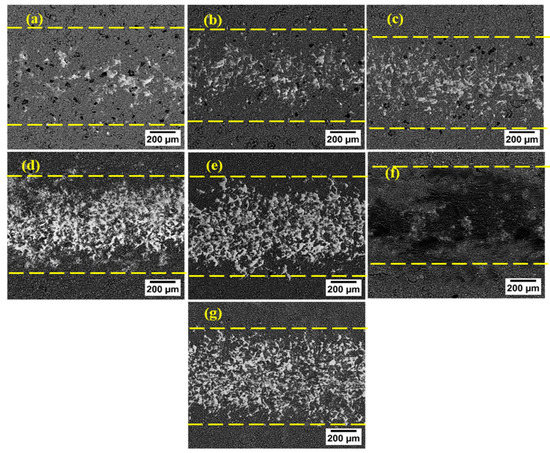
Figure 15.
The SEM images of wear tracks after testing under 5 N normal load; (a) S1, (b) S3, (c) S5, (d) S7, (e) S9, (f) S11, and (g) S13.
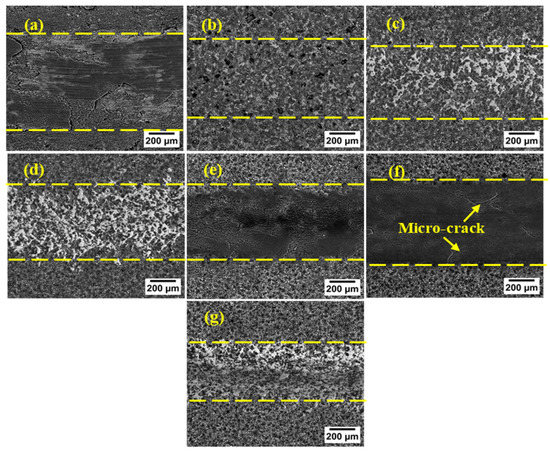
Figure 16.
The SEM images of wear tracks after testing under 5 N normal load: (a) S1W, (b) S3W, (c) S5W, (d) S7W, (e) S9W, (f) S11W, and (g) S13W.
The line profiles of the wear scars were studied and data such as the depth, the width, the ratio of track depth to the thickness of the coating, the worn volume of each scar, and the wear rate were measured as shown in Table 2. As evident in Table 2, the track depth to the thickness ratio of the coatings is 0.60–0.75 for coatings without additives and 0.55–0.65 for the additive-containing ones. Interestingly, the thickness of the coatings was lost in the same ratio. The outer layer has been worn for all samples, but the inner layer has remained safe; thus, the damage has not been intensive in all specimens. Therefore, the higher wear rates, volume losses, track widths, and depths in specimens with a lower silicon content of the substrate are due to the greater thickness of the coating and the outer layer for the coatings both with and without the additive. With the increasing Si content of the substrate, the thickness of the coatings and outer layer decreases; thus, the wear rate is also reduced. The low thickness leads to a decrease in the load-ability and, consequently, should reduce the wear resistance of the coatings [58]. As the schematic image shows in Figure 17, the mechanism of the wear phenomenon in the coatings on the substrate with low and high silicon content is the removal of the outer porous layer.

Table 2.
Wear tracks’ specifications obtained by analysis of line profile specimens.
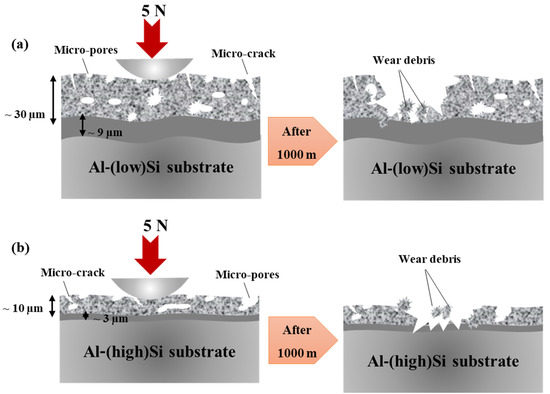
Figure 17.
Schematic of the mechanism of wear phenomenon for substrate with (a) low silicon content, and (b) high silicon content.
The wear resistance of a coating can be affected by its micro-hardness, which is determined by the phase combination and degree of porosity [40,52]. Figure 18 displays the micro-hardness (HV, load = 10 N) and the wear rate of the specimens. The micro-hardness decreases with an increased silicon content of the substrate due to the reduced alumina phase and increased silicon-containing phase and porosity percent of coatings. The Al2O3 compounds have greater micro-hardness than SiO2 and mullite. Accordingly, the higher wear rates of the coatings on the substrates with low silicon content are attributed to their higher thickness. The micro-hardness of the W-containing coatings is higher than that of the prepared coatings in the silicate-based electrolytes. The highest micro-hardness corresponds to S1W (1162 HV). In addition, the wear rate of the tungsten-containing coatings is lower than that of the silicate-based electrolyte coatings; thus, these coatings have superior wear resistance. The affirmation of the effect of low W incorporation on the improvement of the tribological behavior of the 5052 Al alloy is presented by ref. [19].
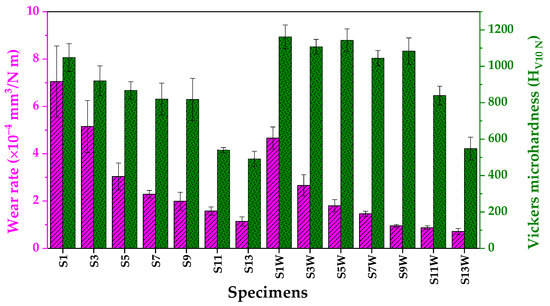
Figure 18.
The wear rate and Vickers micro-hardness (HV10 N) of the PEO-coated samples.
4. Conclusions
The PEO of an Al–xSi alloy was accomplished on a substrate with different silicon contents using a bipolar waveform in an alkaline silicate-based electrolyte without and with a Na2WO4 additive. The following main conclusions can be drawn:
- The bright areas on the surface of the high-Si specimens were mainly composed of silicon oxides. The change in the surface micrographs of the coatings formed in the additive-containing electrolyte is negligible. Furthermore, the effect of the substrate surface’s primary structure was not recognizable for both coatings with and without additives.
- The highest and lowest porosity percentages were measured for the S13 (i.e., 27.46%) and the S1W coating (i.e., 6.68%), respectively. The finer sparking in the electrolyte containing Na2WO4 led to the lower porosity in all of the obtained coatings compared with the coatings produced without the additive electrolyte. In addition, the porosity percent was incremented with the increasing silicon content of the substrate.
- The mean thickness of the coatings was increased by the presence of Na2WO4 (S1W~64.6 μm) in the electrolyte. On the other hand, increasing the Si content of the substrate for the specimens both with and without the additive decreased the average thickness.
- The lower surface roughness was attributed to the coating formed in the additive-containing electrolyte due to its higher conductivity of 21.8 mS cm−1. However, by further increasing the silicon content of the substrate, the coatings became smoother.
- The higher wear rates, volume losses, track widths, and depths were related to the specimens with a lower silicon content of the substrate due to the greater outer layer thicknesses of the coatings. However, the coating produced using the additive-containing electrolyte showed a higher micro-hardness and a lower wear rate in comparison with the coatings produced in the silicate-based electrolyte.
Author Contributions
Conceptualization, M.M., H.E. and A.H.; methodology, M.M. and A.H.; software, M.M.; validation, M.M., H.E. and A.H.; formal analysis, M.M.; investigation, M.M.; resources, M.M.; data curation, M.M.; writing—original draft preparation, M.M.; writing—review and editing, H.E. and A.H.; visualization, M.M. and A.H.; supervision, H.E.; project administration, H.E. All authors have read and agreed to the published version of the manuscript.
Funding
This research received no external funding.
Institutional Review Board Statement
Not applicable.
Informed Consent Statement
Not applicable.
Data Availability Statement
Data sharing is not applicable.
Acknowledgments
I would like to express my gratitude to my late professor, Morteza Zandrahimi, for sharing his knowledge with me throughout this research. His instruction and assistance considerably aided me in becoming an independent problem solver. His memory will always be with me, and I sincerely offer my condolences to his loving family. We are also grateful for the help of the Plasma Oxide Pars Company.
Conflicts of Interest
The authors declare no conflict of interest.
References
- Chu, S.; Majumdar, A. Opportunities and challenges for a sustainable energy future. Nature 2012, 488, 294–303. [Google Scholar] [CrossRef] [PubMed]
- Li, X.; Nie, X.; Wang, L.; Northwood, D.O. Corrosion protection properties of anodic oxide coatings on an Al-Si alloy. Surf. Coat. Technol. 2005, 200, 1994–2000. [Google Scholar] [CrossRef]
- Shirani, A.; Joy, T.; Rogov, A.; Lin, M.; Yerokhin, A.; Mogonye, J.E.; Korenyi-Both, A.; Aouadi, S.M.; Voevodin, A.A.; Berman, D. PEO-Chameleon as a potential protective coating on cast aluminum alloys for high-temperature applications. Surf. Coat. Technol. 2020, 397, 126016. [Google Scholar] [CrossRef]
- Xu, F.; Xia, Y.; Li, G. The mechanism of PEO process on Al-Si alloys with the bulk primary silicon. Appl. Surf. Sci. 2009, 255, 9531–9538. [Google Scholar] [CrossRef]
- He, J.; Cai, Q.Z.; Luo, H.H.; Yu, L.; Wei, B.K. Influence of silicon on growth process of plasma electrolytic oxidation coating on Al-Si alloy. J. Alloys Compd. 2009, 471, 395–399. [Google Scholar] [CrossRef]
- Zhu, B.; Seifeddine, S.; Persson, P.O.Å.; Jarfors, A.E.W.; Leisner, P.; Zanella, C. A study of formation and growth of the anodised surface layer on cast Al-Si alloys based on different analytical techniques. Mater. Des. 2016, 101, 254–262. [Google Scholar] [CrossRef]
- Li, K.; Li, W.; Zhang, G.; Zhu, W.; Zheng, F.; Zhang, D. Effects of Si phase refinement on the plasma electrolytic oxidation of eutectic Al-Si alloy. J. Alloys Compd. 2019, 790, 650–656. [Google Scholar] [CrossRef]
- Mora-Sanchez, H.; del Olmo, R.; Rams, J.; Torres, B.; Mohedano, M.; Matykina, E.; Arrabal, R. Hard Anodizing and Plasma Electrolytic Oxidation of an Additively Manufactured Al-Si alloy. Surf. Coat. Technol. 2021, 420, 127339. [Google Scholar] [CrossRef]
- Mistry, K.; Priest, M.; Shrestha, S. The potential of plasma electrolytic oxidized eutectic aluminium-silicon alloy as a cylinder wall surface for lightweight engine blocks. Proc. Inst. Mech. Eng. Part J J. Eng. Tribol. 2010, 224, 221–229. [Google Scholar] [CrossRef]
- Barati Darband, G.; Aliofkhazraei, M.; Hamghalam, P.; Valizade, N. Plasma electrolytic oxidation of magnesium and its alloys: Mechanism, properties and applications. J. Magnes. Alloy. 2017, 5, 74–132. [Google Scholar] [CrossRef]
- Tjiang, F.; Ye, L.W.; Huang, Y.J.; Chou, C.C.; Tsai, D.S. Effect of processing parameters on soft regime behavior of plasma electrolytic oxidation of magnesium. Ceram. Int. 2017, 43, S567–S572. [Google Scholar] [CrossRef]
- Lu, X.; Mohedano, M.; Blawert, C.; Matykina, E.; Arrabal, R.; Kainer, K.U.; Zheludkevich, M.L. Plasma electrolytic oxidation coatings with particle additions—A review. Surf. Coat. Technol. 2016, 307, 1165–1182. [Google Scholar] [CrossRef]
- Wang, L.; Nie, X. Silicon effects on formation of EPO oxide coatings on aluminum alloys. Thin Solid Films 2006, 494, 211–218. [Google Scholar] [CrossRef]
- Alves, S.A.; Fern, P.; Bay, R. Enhanced tribological performance of cylinder liners made of cast aluminum alloy with high silicon content through plasma electrolytic oxidation. Surf. Coat. Technol. 2022, 433, 128146. [Google Scholar] [CrossRef]
- Polunin, A.V.; Cheretaeva, A.O.; Borgardt, E.D.; Rastegaev, I.A.; Krishtal, M.; Katsman, A.V.; Yasnikov, I.S. Improvement of oxide layers formed by plasma electrolytic oxidation on cast Al–Si alloy by incorporating TiC nanoparticles. Surf. Coat. Technol. 2021, 423, 127603. [Google Scholar] [CrossRef]
- Wen, L.; Wang, Y.; Zhou, Y.; Ouyang, J.; Guo, L.; Jia, D. Corrosion evaluation of microarc oxidation coatings formed on 2024 aluminium alloy. Corros. Sci. 2010, 52, 2687–2696. [Google Scholar] [CrossRef]
- Olmo, R.; Mohedano, M.; Visser, P.; Matykina, E.; Arrabal, R. Flash-PEO coatings loaded with corrosion inhibitors on AA2024. Surf. Coat. Technol. 2020, 402, 126317. [Google Scholar] [CrossRef]
- Yan, H.; Liu, W.; Yu, Z.; Liu, B.; Liu, C. Effect of Sodium Tungstate on the Microstructure and Properties of Micro-Arc Oxidized Coatings Formed on 2A12 Aluminum Alloy. J. Mater. Eng. Perform. 2021, 30, 7741–7751. [Google Scholar] [CrossRef]
- Tseng, C.C.; Lee, J.L.; Kuo, T.H.; Kuo, S.N.; Tseng, K.H. The influence of sodium tungstate concentration and anodizing conditions on microarc oxidation (MAO) coatings for aluminum alloy. Surf. Coat. Technol. 2012, 206, 3437–3443. [Google Scholar] [CrossRef]
- Toulabifard, A.; Hakimizad, A.; Di Franco, F.; Raeissi, K.; Santamaria, M. Synergistic effect of W incorporation and pulsed current mode on wear and tribocorrosion resistance of coatings grown by plasma electrolytic oxidation on 7075 Al alloy. Mater. Res. Express. 2019, 6, 106502. [Google Scholar] [CrossRef]
- Hakimizad, A.; Raeissi, K.; Santamaria, M.; Asghari, M. Effects of pulse current mode on plasma electrolytic oxidation of 7075 Al in Na2WO4 containing solution: From unipolar to soft-sparking regime. Electrochim. Acta J. 2018, 164, C690–C698. [Google Scholar] [CrossRef]
- Vander Voort, G.F.; Asensio-lozano, J. The Al-Si Phase Diagram. Microsc. Microanal. 2009, 15, 60–61. [Google Scholar] [CrossRef]
- Uguz, A.; Bayram, A. Effect of Si content and microstructure on the wear behaviour of Al-Si alloys. Metall 2001, 55, 758–761. [Google Scholar]
- Dahle, A.K.; Nogita, K.; McDonald, S.D.; Dinnis, C.; Lu, L. Eutectic modification and microstructure development in Al-Si Alloys. Mater. Sci. Eng. A 2005, 413–414, 243–248. [Google Scholar] [CrossRef]
- Zheng, H.Y.; Wang, Y.K.; Li, B.S.; Han, G.R. The effects of Na2WO4 concentration on the properties of microarc oxidation coatings on aluminum alloy. Mater. Lett. 2005, 59, 139–142. [Google Scholar] [CrossRef]
- Di Chen, X.; Cai, Q.Z.; Yin, L.S. Effects of Na2WO4 Additive on Properties of Plasma Electrolytic Oxidation Coatings on 6061 Al Alloy. Adv. Chem. Eng. II 2012, 550–553, 1969–1975. [Google Scholar] [CrossRef]
- Hussein, R.O.; Nie, X.; Northwood, D.O. An investigation of ceramic coating growth mechanisms in plasma electrolytic oxidation (PEO) processing. Electrochim. Acta 2013, 112, 111–119. [Google Scholar] [CrossRef]
- Rogov, A.B.; Yerokhina, A.; Matthewsa, A. The role of cathodic current in plasma electrolytic oxidation of aluminum: Phenomenological concepts of the “soft sparking” mode. Prepr. Langmuir. 2017, 33, 11059–11069. [Google Scholar] [CrossRef]
- Tillous, K.; Toll-Duchanoy, T.; Bauer-Grosse, E.; Hericher, L.; Geandier, G. Microstructure and phase composition of microarc oxidation surface layers formed on aluminium and its alloys 2214-T6 and 7050-T74. Surf. Coat. Technol. 2009, 203, 2969–2973. [Google Scholar] [CrossRef]
- Wang, P.; Li, J.P.; Guo, Y.C.; Yang, Z.; Wang, J.L. Ceramic coating formation on high Si containing Al alloy by PEO process. Surf. Eng. 2016, 32, 428–434. [Google Scholar] [CrossRef]
- Li, K.; Yao, W.; Xie, Y.; Zhang, J.; Li, B.; Wan, Z.; Zhang, Z.; Lu, L.; Tang, Y. AC plasma electrolytic oxidation of additively manufactured and cast AlSi12 alloys. Surf. Coat. Technol. 2020, 399, 125708. [Google Scholar] [CrossRef]
- Terleeva1, O.P.; Oh, Y.; Slonova, A.I.; Kireenko, I.B.; Ok, M.-R.; Ha, H.-P. Quantitative parameters and definition of stages of anodic-cathodic microplasma processes on aluminum alloys. Mater. Trans. 2005, 46, 2077–2082. [Google Scholar] [CrossRef][Green Version]
- Sah, S.P.; Tsuji, E.; Aoki, Y.; Habazaki, H. Cathodic pulse breakdown of anodic films on aluminium in alkaline silicate electrolyte—Understanding the role of cathodic half-cycle in AC plasma electrolytic oxidation. Corros. Sci. 2012, 55, 90–96. [Google Scholar] [CrossRef]
- Duan, H.; Yan, C.; Wang, F. Growth process of plasma electrolytic oxidation films formed on magnesium alloy AZ91D in silicate solution. Electrochim. Acta 2007, 52, 5002–5009. [Google Scholar] [CrossRef]
- Chang, L. Growth regularity of ceramic coating on magnesium alloy by plasma electrolytic oxidation. J. Alloys Compd. 2009, 468, 462–465. [Google Scholar] [CrossRef]
- Li, K.; Zhang, G.; Yi, A.; Zhu, W.; Liao, Z.; Chen, K.; Li, W.; Luo, Z. Effects of Matrix Silicon Content on the Plasma Electrolytic Oxidation of Al-Si Alloys Using Different Power Modes. Crystals 2022, 12, 123. [Google Scholar] [CrossRef]
- Clyne, T.W.; Troughton, S.C. A review of recent work on discharge characteristics during plasma electrolytic oxidation of various metals. Int. Mater. Rev. 2019, 64, 127–162. [Google Scholar] [CrossRef]
- Madhan Kumar, A.; Kwon, S.H.; Jung, H.C.; Shin, K.S. Corrosion protection performance of single and dual Plasma Electrolytic Oxidation (PEO) coating for aerospace applications. Mater. Chem. Phys. 2015, 149, 480–486. [Google Scholar] [CrossRef]
- Cheng, Y.L.; Xue, Z.G.; Wang, Q.; Wu, X.Q.; Matykina, E.; Skeldon, P.; Thompson, G.E. New findings on properties of plasma electrolytic oxidation Coatings from study of an Al-Cu-Li alloy. Electrochim. Acta 2013, 107, 358–378. [Google Scholar] [CrossRef]
- Hussein, R.O.; Northwood, D.O.; Su, J.F.; Nie, X. A study of the interactive effects of hybrid current modes on the tribological properties of a PEO (plasma electrolytic oxidation) coated AM60B Mg-alloy. Surf. Coat. Technol. 2013, 215, 421–430. [Google Scholar] [CrossRef]
- Xiang, N.; Song, R.G.; Wang, C.; Mao, Q.Z.; Ge, Y.J.; Ding, J.H.; Song, R.G.; Wang, C.; Mao, Q.Z.; Ge, Y.J.; et al. Formation of corrosion resistant plasma electrolytic oxidation coatings on aluminium alloy with addition of sodium tungstate species. Corros. Eng. Sci. Technol. 2016, 51, 146–154. [Google Scholar] [CrossRef]
- Dai, L.; Li, W.; Zhang, G.; Fu, N.; Duan, Q. Anti-corrosion and wear properties of plasma electrolytic oxidation coating formed on high Si content Al alloy by sectionalized oxidation mode. J. Phys. Conf. Ser. Mater. Sci. Eng. 2016, 167, 012063. [Google Scholar] [CrossRef]
- Hashemzadeh, M.; Raeissi, K.; Ashrafizadeh, F.; Hakimizad, A.; Santamaria, M.; Lampke, T. Silicate and Hydroxide Concentration Influencing the Properties of Composite Al2O3-TiO2 PEO Coatings on AA7075 Alloy. Coatings 2022, 12, 33. [Google Scholar] [CrossRef]
- Hussein, R.O.; Nie, X.; Northwood, D.O.; Yerokhin, A.; Matthews, A. Spectroscopic study of electrolytic plasma and discharging behaviour during the plasma electrolytic oxidation (PEO) process. J. Phys. D Appl. Phys. 2010, 43, 105–203. [Google Scholar] [CrossRef]
- Hussein, R.O.; Zhang, P.; Nie, X.; Xia, Y.; Northwood, D.O. The effect of current mode and discharge type on the corrosion resistance of plasma electrolytic oxidation (PEO) coated magnesium alloy AJ62. Surf. Coat. Technol. 2011, 206, 1990–1997. [Google Scholar] [CrossRef]
- Hussein, R.O.; Northwood, D.O. Improving the performance of magnesium alloys for automotive applications. WIT Trans. Built Environ. 2014, 137, 531–544. [Google Scholar] [CrossRef]
- Blawert, C.; Srinivasan, P.B. 6—Plasma electrolytic oxidation treatment of magnesium alloys. In Surface Engineering Light Alloy; Dong, H., Ed.; Woodhead Publishing: Sawston, UK; GKSS-Forschungszentrum Geesthacht GmbH: Geesthacht, Germany, 2010; Volume 1, pp. 155–183. [Google Scholar] [CrossRef]
- Jiang, B.L.; Wang, Y.M. Plasma electrolytic oxidation treatment of aluminium and titanium alloys. In Surface Engineering Light Alloy; Dong, H., Ed.; Woodhead Publishing: Sawston, UK; Xi’an University of Technology: Xi’an, China, 2010; Volume 1, pp. 110–154. [Google Scholar]
- Hussein, R.O.; Northwood, D.O.; Nie, X. Processing-Microstructure Relationships in the Plasma Electrolytic Oxidation (PEO) Coating of a Magnesium Alloy. Mater. Sci. Appl. 2014, 5, 124–139. [Google Scholar] [CrossRef]
- Lu, X.; Blawert, C.; Scharnagl, N.; Kainer, K.U. Influence of incorporating Si3N4 particles into the oxide layer produced by plasma electrolytic oxidation on AM50 Mg alloy on coating morphology and corrosion properties. J. Magnes. Alloy. 2013, 1, 267–274. [Google Scholar] [CrossRef]
- Hwang, I.J.; Shin, K.R.; Lee, J.S.; Ko, Y.G.; Shin, D.H. Formation of Black Ceramic Layer on Aluminum Alloy by Plasma Electrolytic Oxidation in Electrolyte Containing Na2WO4. Mater. Trans. 2012, 53, 559–564. [Google Scholar] [CrossRef]
- Stojadinovic, S.; Vasilic, R.; Belca, I.; Petkovic, M.; Kasalica, B.; Nedic, Z.; Zekovic, L. Characterization of the plasma electrolytic oxidation of aluminium in sodium tungstate. Corros. Sci. 2010, 52, 3258–3265. [Google Scholar] [CrossRef]
- Li, H.; Yin, Z.; Deng, L.; Wang, S.; Fu, Z.; Ma, Y. Effect of SiO2/Al2O3 ratio on the structure and electrical properties of MgO–Al2O3–SiO2 glass-ceramics doped with TiO2. Mater. Chem. Phys. 2020, 256, 3–9. [Google Scholar] [CrossRef]
- Hakimizad, A.; Raeissi, K.; Golozar, M.A.; Lu, X.; Blawert, C.; Zheludkevich, M.L. Influence of cathodic duty cycle on the properties of tungsten containing Al2O3/TiO2 PEO nano-composite coatings. Surf. Coat. Technol. 2018, 340, 210–221. [Google Scholar] [CrossRef]
- Forn, A.; Picas, J.A.; Baile, M.T.; Martin, E.; García, V.G. Microstructure and tribological properties of anodic oxide layer formed on Al-Si alloy produced by semisolid processing. Surf. Coat. Technol. 2007, 202, 1139–1143. [Google Scholar] [CrossRef]
- Malayoglu, U.; Tekin, K.C.; Malayoglu, U.; Shrestha, S. An investigation into the mechanical and tribological properties of plasma electrolytic oxidation and hard-anodized coatings on 6082 aluminum alloy. Mater. Sci. Eng. A 2011, 528, 7451–7460. [Google Scholar] [CrossRef]
- Durdu, S.; Bayramoglu, S.; Demirtaş, A.; Usta, M.; Üçşk, A.H. Characterization of AZ31 Mg Alloy coated by plasma electrolytic oxidation. Vacuum 2013, 88, 130–133. [Google Scholar] [CrossRef]
- Evangeline, A.; Sathiya, P.; Prabu, S.S.; Devendranath, K.; Arivazhagan, N. Effect of Coating Thickness on Wear Performance of Inconel 625 coating. IOP Conf. Ser. Mater. Sci. Eng. Pap. 2018, 423, 012159. [Google Scholar] [CrossRef]
- Zhang, Y.; Chen, F.; Zhang, Y.; Du, C. Influence of graphene oxide additive on the tribological and electrochemical corrosion properties of a PEO coating prepared on AZ31 magnesium alloy. Tribol. Int. 2020, 146, 106135. [Google Scholar] [CrossRef]
- Arrabal, R.; Mohedano, M.; Mingo, B.; Matykina, E.; Pardo, A.; Merino, M.C. Characterization and wear behaviour of PEO coatings on 6082-T6 aluminum alloy with incorporated α-Al2O3 particles. Surf. Coat. Technol. 2015, 269, 64–73. [Google Scholar] [CrossRef]
- Wang, Z.; Wu, L.; Qi, Y.; Cai, W.; Jiang, Z. Self-lubricating Al2O3/PTFE composite coating formation on surface of aluminium alloy. Surf. Coat. Technol. 2010, 204, 3315–3318. [Google Scholar] [CrossRef]
- Rahmati, M.; Raeissi, K.; Toroghinejad, M.R.; Hakimizad, A.; Santamaria, M. Corrosion and wear resistance of coatings produced on AZ31 Mg alloy by plasma electrolytic oxidation in silicate-based K2TiF6 containing solution: Effect of waveform. J. Magnes. Alloy. 2021. [Google Scholar] [CrossRef]
- Li, Z.; Di, S. Preparation and properties of microarc oxidation self-lubricating composite coatings on aluminum alloy. Metals 2017, 7, 127. [Google Scholar] [CrossRef]
Publisher’s Note: MDPI stays neutral with regard to jurisdictional claims in published maps and institutional affiliations. |
© 2022 by the authors. Licensee MDPI, Basel, Switzerland. This article is an open access article distributed under the terms and conditions of the Creative Commons Attribution (CC BY) license (https://creativecommons.org/licenses/by/4.0/).